
Hérault is a department of the region of Occitania, Southern France. Named after the Hérault River, its prefecture is Montpellier. It had a population of 1,175,623 in 2019.
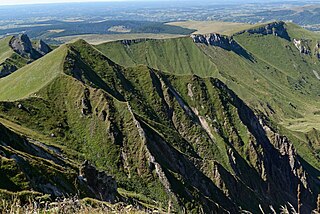
The Massif Central is a highland region in south-central France, consisting of mountains and plateaus. It covers about 15% of mainland France.

The Cévennes is a cultural region and range of mountains in south-central France, on the south-east edge of the Massif Central. It covers parts of the départements of Ardèche, Gard, Hérault and Lozère. Rich in geographical, natural, and cultural significance, portions of the region are protected within the Cévennes National Park, the Cévennes Biosphere Reserve (UNESCO), as well as a UNESCO World Heritage Site: Causses and the Cévennes, Mediterranean agro-pastoral Cultural Landscape. The area has been inhabited since 400,000 BCE and has numerous megaliths which were erected beginning around 2500 BCE. As an agriculturally-rich area, but not a suitable location for cities, the Cévennes developed a wide diversity of pastoral systems, including transhumance. The irrigation and road networks put in place in the early Middle Ages for these pastoral systems are still in use today.
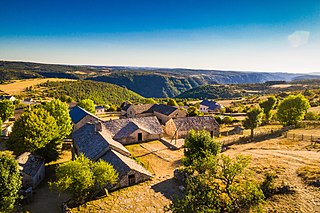
Cévennes National Park is a French national park located in Southern France, in the mountainous area of Cévennes.

Les Eyzies-de-Tayac-Sireuil is a former commune in the Dordogne department in Nouvelle-Aquitaine in southwestern France. On 1 January 2019, it was merged into the new commune Les Eyzies.

The Causses are a group of limestone plateaux in the Massif Central. They are bordered to the north-west by the Limousin and the Périgord uplands, and to the east by the Aubrac and the Cévennes. Large rivers gorges cut through the plateaux, such as the Tarn, Dourbie, Jonte, Lot the Vis (river) and Aveyron. Causse is an Occitan word meaning "limestone plateau" coming from the latin word calx meaning limestone or chalk.

The Cirque de Navacelles is large erosional landform, an incised meander, located towards the southern edge of the Massif Central mountain range in France. It is located near Saint-Maurice-Navacelles and Blandas between the Hérault department and the Gard department.

Édouard-Alfred Martel, the 'father of modern speleology', was a world pioneer of cave exploration, study, and documentation. Martel explored thousands of caves in his native France and many other countries, popularised the pursuit of cave exploration, introduced the concept of speleology as a distinct area of scientific study, maintained an extensive archive, and in 1895 founded Société de Spéléologie, the first organisation devoted to cave science in the world.

The Cave of the Trois-Frères is a cave in southwestern France famous for its cave paintings. It is located in Montesquieu-Avantès, in the Ariège département. The cave is named for three brothers, Max, Jacques, and Louis Begouën, who, along with their father Comte Henri Begouën, discovered it in 1914. The drawings of the cave were made famous in the publications of the Abbé Henri Breuil. The cave art appears to date to approximately 13,000 BC.

Prehistoric France is the period in the human occupation of the geographical area covered by present-day France which extended through prehistory and ended in the Iron Age with the Roman conquest, when the territory enters the domain of written history.

Roc-aux-Sorciers is an Upper Paleolithic rock shelter site dating to the mid-Magdalenian cultural stage, ca 14,000 yBP, made famous by its relief wall carvings. The site is in the French commune of Angles-sur-l'Anglin, in Vienne. The name 'Sorcerers' Rock', with its suggestions of pagan rendez-vous, was applied to the site long before the wall-carvings were discovered.
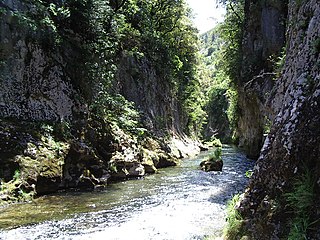
The Vis is a 57.8-kilometre-long (35.9 mi) river in south-central France, in the Occitanie administrative region. It is a right tributary of the Hérault. Its source is in the Cévennes, near the village of Alzon. It flows between the Causse du Larzac and the Causse de Blandas into the Hérault and Gard departments. The Vis flows into the Hérault near Ganges.
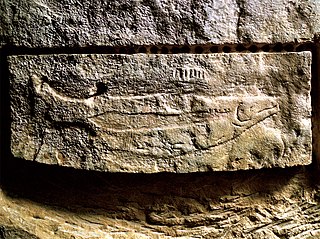
The Prehistoric Sites and Decorated Caves of the Vézère Valley is a UNESCO World Heritage Site in France since 1979. It specifically lists 15 prehistoric sites in the Vézère valley in the Dordogne department, mostly in and around Les Eyzies-de-Tayac-Sireuil, which has been called the "Capital of Prehistory". This valley is exceptionally rich in prehistoric sites, with more than 150 known sites including 25 decorated caves, and has played an essential role in the study of the Paleolithic era and its art. Three of the sites are the namesakes for prehistoric periods; the Micoquien, Mousterian, and Magdalenian. Furthermore, the Cro-Magnon rock shelter gave its name to the Cro-Magnon, the generic name for the European early modern humans. Many of the sites were discovered or first recognised as significant and scientifically explored by the archaeologists Henri Breuil and Denis Peyrony in the early twentieth century, while Lascaux, which has the most exceptional rock art of these, was discovered in 1940.
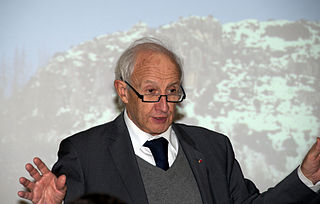
Henry de Lumley is a French archeologist, geologist and prehistorian. He is director of the Institute of Human Paleontology in Paris, and Professor Emeritus at the National Museum of Natural History in Paris. He is also a corresponding member of the Academy of Humanities of the Institute of France and former director of the French National Museum of Natural History. He is best known for his work on archeological sites in France and Spain, notably Arago cave in Tautavel, Southern France, Terra Amata in Nice and Grotte du Lazaret near Nice, and Baume Bonne at Quinson, where some of the earliest evidence of man in Europe were found.
André Niederlender was a French archaeologist and prehistorian, who explored prehistorical sites in Lot, France.

The Pair-non-Pair Cave is located near the village of Prignac-et-Marcamps, Aquitaine:Gironde (33) department in France. Only discovered in 1881 it is known for remarkable prehistoric parietal engravings - petroglyphic representations of wild animals, "which rank among the most ancient examples of art made by prehistoric" humans, dating back to between 30,000 and 25,000 BP, the Aurignacian cultural period of the Upper Paleolithic.

Gabrielle Vallot was a French climber, mountaineer, and speleologist. She married scientist and mountaineer Joseph Vallot in 1880, and they climbed Mont-Blanc together.

Alfred Émile Reinaud was a French lawyer, politician and essayist who served as mayor of Nîmes from 1892 to 1900. Reinaud was also a prominent member of the Académie de Nîmes.

Miss Languedoc is a French beauty pageant which selects a representative for the Miss France national competition from the departments of Aude, Gard, Hérault, and Lozère in the region of Languedoc-Roussillon. Until 2023, the organization was known as Miss Languedoc-Roussillon and also represented the department of Pyrénées-Orientales, sometimes through the Miss Roussillon sister pageant, until the department's separation into the independent Miss Roussillon organization. The first Miss Languedoc-Roussillon was crowned in 1976, although several women have represented the region with various other titles.


























